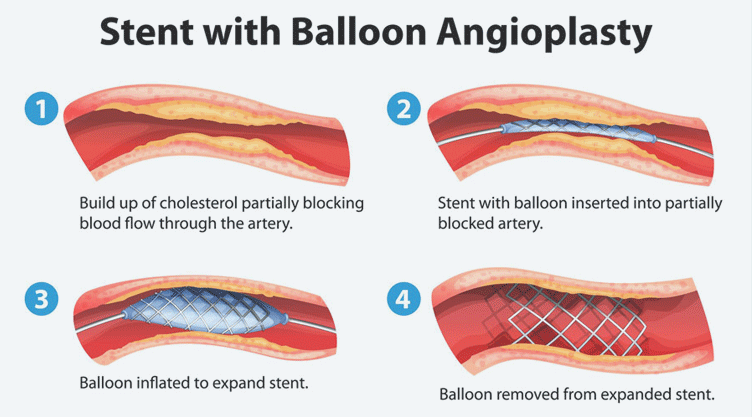Cardiac Procedures
Angioplasty

Angioplasty
The Procedure
Imagine your blood vessels like pipes, and blood flowing through them like water. Angioplasty is like using a tiny tool to unclog a pipe. Here’s how it works:
Preparation: First, you’ll be given some medicine to help you relax, and the area where the doctor will work (usually the groin or wrist) will be cleaned and numbed.
Inserting the Catheter: A thin, flexible tube called a catheter is gently threaded through your blood vessels until it reaches the clogged area.
The Balloon: Attached to the catheter is a tiny balloon. Once the catheter reaches the clogged spot, the doctor inflates the balloon. Just like blowing up a balloon, this expands the narrowed artery, creating more space for blood to flow.
Smoothing Things Out: The balloon isn’t left inflated forever. It’s deflated and taken out, but often a small mesh tube called a stent is left behind. This acts like a scaffold, holding the artery open. Some stents are even coated with medicine to prevent further clogs.
Recovery: After the angioplasty procedure, you’ll rest for a bit. Many people can go home the same day or the next day. Your doctor will give you instructions on how to take care of yourself as you heal.
Benefits and Considerations
Angioplasty can help improve blood flow, relieve chest pain, and even save lives during a heart attack. It’s less invasive than open-heart surgery and usually has a shorter recovery time. However, like any medical procedure, there are risks involved. Your cardiologist will discuss these with you and help you decide if angioplasty is the right choice for you.
Angioplasty might sound like a complex procedure, but it’s about restoring proper blood flow and keeping our hearts happy. By understanding the basics of angioplasty, you’re better equipped to have meaningful discussions with your cardiologist if the need ever arises.












